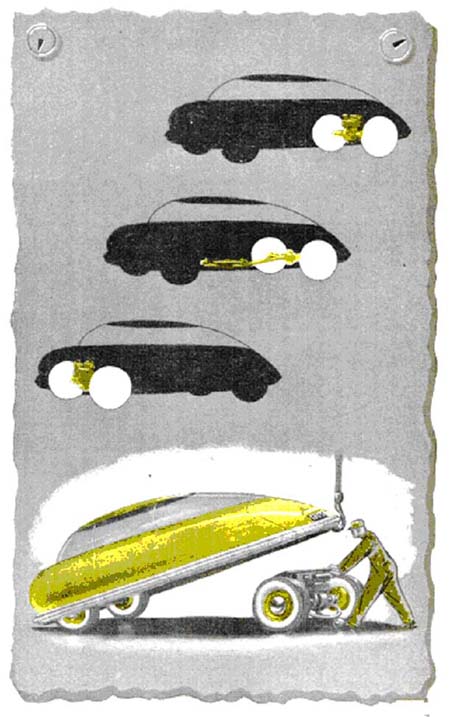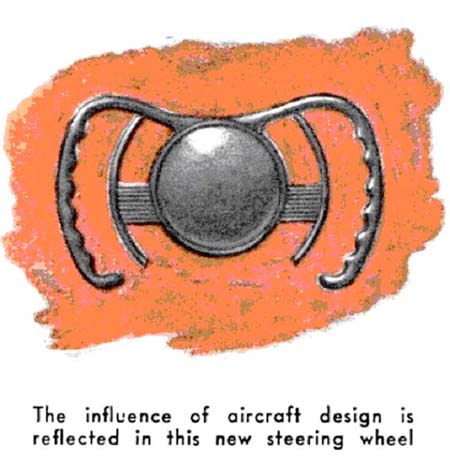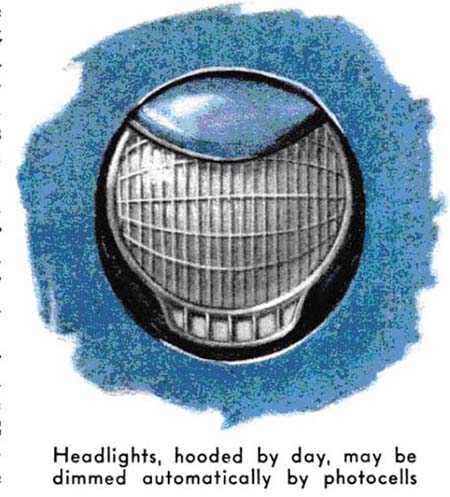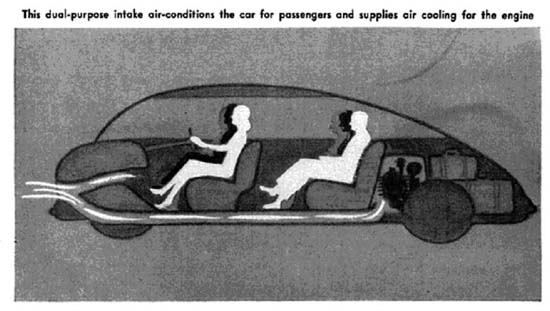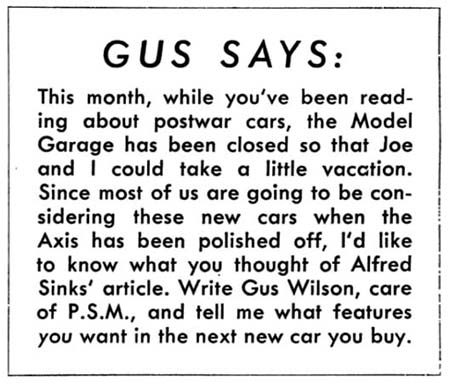December 1943
PREVIEWING
YOUR POSTWAR CAR
by Alfred H. Sinks
Higher Power From Smaller Engines,
Extra Roominess, and Simpler Operation
Are Some Of The Goals Toward Which Builders Are Aiming
What will it be like, the next new car you buy? The automobile industry has given part of the answer. The first new cars to roll off the production lines will be 1942 models, with minor changes. Your wonder car of the future will have to simmer on the back of the stove while the manufacturers hurry to catch up with the immediate postwar demand.
Tools and dies for 1942 models -- the last made before our automobile plants were converted to war work -- are now in storage. Within four to six months after war production slacks off, dies can be moved back onto the factory floors, machines can be set for automobile parts instead of weapons, and cars can begin to roll. To get ready to manufacture a brand new model might take at least a year, and that would be valuable time to lose when the floodgates of postwar demand for automobiles are opened.
But after that first new car, then what? The whole transportation world is throbbing with changes to come. New discoveries pouring from laboratories and war industries are smashing conventional ideas of construction and design, and it is certain that they will have tremendous influences on automobiles. Designers are even now working overtime to bring their plans for future cars in line with the latest developments in engineering.
How soon will that next car come? Not all are agreed. Within a year or two after the war ends in Europe, some independent designers declare , you'll be driving cars that are mechanical miracles. As soon as the Government lets them have the materials say others, or as soon as factory space and machines can be spared from war production. On the conservative side stand most of the big automobile manufacturers. Dream cars will be a long time coming, they insist. There will be no revolutionary steps, they say: and progress will be evolutionary in the future just as it has always been in the past.
Whatever he may tell you, your automobile dealer himself is dead set against rapid changes in design. He sells used cars as well as new ones. If models change too rapidly, the used cars soon begin to look like antiques and lose resale value.
Then, too, the public is going to have a say. It is public taste most of all, the manufacturers dealers, that dictates design. The public will not accept radical, sudden changes in appearance, many of the established makers believe. And in the past it has been what a car looked like on the outside, not what it was like inside, that attracted most buyers. There may be a revaluation of this idea, though, when the new cars go on sale, for the sponsors may find that, with millions employed in industrial plants during the war, Americans and especially American women have become more machinery-minded.
Public imagination has been fired by war technology. There is the versatile jeep -- not so much to look at, perhaps, but a wonder on the road and even off the road. Tanks, halftracks, and motorized gun carriages have proved that they can take it. And what of the sleek beauty of our fighting planes? Will the public want some of that transferred to its automobiles? Many of the designers think so. And they think, too, that the public will demand some of the engine performance of modern bombers and fighters
"Already teardrop and airfoil lines are prominent in the designs that are being considered. They will replace to a large extent the so-called streamlining that before the war had encumbered many of our models with metal over wasted air space and with useless chromium decoration. Manufacturers would have eliminated this chromium plate long ago if careful surveys had not indicated that plenty of "brightwork" sold secondhand cars. The break at the end of the war may give them their chance.
Undoubtedly the new car will be shorter and easier to turn than our old models. Extra length and wasted bulk have lessened maneuverability in the past. But though the new car may be smaller, it will be much roomier because of its different shape. Its hood will be shrunk to a fraction of the present size, or it will be gone altogether, and its humps and angles will give way to the clean lines of a fast fighter plane. There will be no wasted space under the hood and the new motor will be much smaller.
Fenders are slated to disappear entirely, and bumpers will extend completely around the car, offering some protection in sideswipes as well as in front and rear collisions. Over the wheels, these bumpers will be in sections that can be removed easily when a tire is to be changed. Instead of being made of rigid metal that transfers the shock of impact to the body, bumpers will be flexible and will absorb a jar, minimizing damage to the car.
The windshield and windows will curve with the contours of the body. They may be of laminated glass, or they may be of clear, transparent plastic that will be as strong as the body of the car and permit a construction with no corner posts, thus providing complete vision without blind spots.
In fact, the plastics industry is keenly interested in your new car, and plastics may play a big part in its design. Opaque plastics, with the color molded right into the material, would do away with the expense of painting. Clear plastics can now be toughened so that they resist abrasion nearly as well as glass. Used in place of glass, they would save weight and increase safety.
Whatever the material of the body, it will make your car lighter. Aluminum and magnesium will be far cheaper and more abundant than seemed possible a few years ago. They may be used in the body and are sure to be used for crankcases and other engine parts and for sections of the chassis. Bonded compressed plywood, such as made history with the Mosquito bombers, is being given serious consideration for bodies. It has proven strength, durability, and lightness.
So much for the outward appearances and frame of your new car. What about its performance?
With continued improvement in fuel quality and progress in the engine builder's art, you will see automobile engine shrink to teakettle size. It will be entirely new, designed with small cylinders and a high-compression ratio to utilize 85 to 95 octane gasoline. Such gasoline will be available in large quantities after the war, and petroleum men expect octane values to climb rapidly while engines grow smaller. You can count on more and more miles per gallon from these new engines with no top limit yet in sight. Moreover, you'll probably have a super charger to give you an extra push up a steep incline or a burst of extra speed for a fast getaway.
Shall the engine be air-cooled or liquid-cooled, V-type, in-line, radial or pancake? Where shall it be placed -- front, rear, or center? Your tiny engine will be mounted where it will be least in the way. It may be tucked away in the rear, still leaving room for a luggage compartment above it. It may be a pancake type under the floor near the center of gravity. Or it may ride inconspicuously over the front axle. One new design calls for a small radial engine mounted over each wheel. Another contemplates the use of a powerful pump that will drive a set of turbines, one on each wheel.
Motors will be designed to save you time and money by being made easy to service. One new engine can be given a complete overhaul in two hours. A "top overhaul" -- the kind that generally takes your garageman a day -- can be done in 45 minutes.
One automobile manufacturer is working on a model in which the engine and the rear wheels are a single unit, fastened to the body by four bolts. You drive into the garage. The mechanic jacks up the rear end of the car, unfastens the motor unit -- wheels and all -- and rolls away. Then he trundles up a "loaner" unit, bolts that in place, and away you go. A complete overhaul of your engine will take no more of your time than a 10-minute stop on your way to work and another 10-minutes stop on your way home.
You will never need to bother about filling the radiator. Your motor will either be air-cooled or it will have a sealed cooling system that will need no draining, cleaning, or other attention. Many parts of the engine may be permanently sealed. Ignition systems that cannot get out of whack are now within reach. Even the carburetor may give way to an entirely new device that will inject the liquid fuel directly into the cylinders.
Once every 20,000 miles or so you may still have to change the oil. But your main lubrication worry -- burned-out bearings -- will be forgotten. Self-lubricating bearings made through the magic of the new powder metallurgy are one answer. Other designers favor bearings made of indium or silver, or steel roller bearings such as are used in aircraft engines.
Crankshafts, connecting rods, gears, and springs will probably be built of the new NE "lean alloy" steels. Developed under pressure of war scarcities these steels are light and strong. Through what the industry calls the "vitamin" treatment, they are hardened by the addition of inexpensive chemicals instead of expensive alloy metals.
The steering wheel will be modeled after those of our latest bombers -- a light segment instead of a full wheel -- and will not crowd you when you get in or out. The old skin-barking steering post was slanted for leverage. Power steering will make that unnecessary. This power steering is in itself a remarkable achievement. It seems that with just slight pressure, you can guide your car through the hardest turns. The work is done for you by the power system built into the steering gear.
The power-drive principle will also be found in the brakes. There will be just two pedals on the floor of the new car -- a brake and an accelerator. Because of power braking, only light pressure will be needed to bring you to a smooth stop. Don't look for a clutch pedal or a gear-shift lever. Automatic transmission -- born of the device that swings the giant guns on our battleships -- is definitely on the board for future cars.
Eyelids on your headlamps may be lowered during the day, protecting the lenses from dust, and raised at night to reveal powerful lights no larger than the head of a good steel flashlight. Accidents and discomfort from the blinding glare of the headlamps of an approaching car will be done away with. A simple photocell device will dim the lamps of both cars automatically, leaving plenty of light to see by. With a small knob on the dashboard, you will be able to swing your headlamps to either side. In rain, snow, or sleet, a new device will clean the glass without a windshield wiper darting back and forth and interfering with your vision.
You future car will give you all the thrills you can ask. It will travel like the wind and stop on a dime. But the risk and discomfort that used to go with high speed will be missing. Marvelous new spring systems will smooth out the bumps as the dead weight of the old models never did. They will be variable, so that the car will ride as well with a single passenger as with four or five.
Rubber springs have been developed. One is the B. F. Goodrich Co. "Torsilastic" spring; another employs an air-cushion principle. Both take the tossing out of driving over rough roads. With tires that have less bounce adding still further to your comfort, a bump will only make you sink deeper into the sponge-rubber cushion of your seat.
Handsome, easy-cleaning fabrics made of nylon, spun glass, or a host of other synthetic and natural materials that had not even been thought of a few years ago will cover the seats. Some models may have movable chairs; others will have a rear seat arrangement that can be made up as a couch or bed.
In present-day cars there are as many as 125 different parts of natural or synthetic rubber. Both of these materials probably will play an even bigger role in the future cars. Builders will have to keep a sharp eye in particular on the laboratories of synthetic chemists. In fact, hundreds of industries want to help design your future car. Already there is keen competition for a part in its production, and from that competition the car buyer will benefit.
Tire trouble and mechanical failure will be the least of your worries. One company expects tires to be five pounds lighter and stand 20 percent more wear than those of the prewar era. And future cars may be engineered to give good service for decades.
In that case, following the lead of the airlines, you'll simply replace each part as it wears out instead of trading the old chariot in on a new one. Ford tri-motored all-metal planes are still carrying passengers in South America after 12,000,000 miles of service. "If we can build planes to last a lifetime, why not cars?" designers are asking.
Push-button control will open doors and windows either electrically or hydraulically. Some manufacturers will try to convince you that windows should never be opened. They would prefer to save weight and get a more streamlined effect through sealed windows set flush with the body. Sooner or later you will get used to the idea, for air conditioning is likely to become general instead of being a de luxe extra as it is now. It will give you all the fresh air you want, and it will keep you warm in winter and cool in summer. Heating will probably be of the radiothermic type so that every part of the car is heated to a predetermined, uniform, and thermostatically controlled degree.
Gone will be rumbles, rattles, and squeaks. Body and frame will be a single unit, with fewer parts to rub against one another. Soundproofing similar to that in airliners will eliminate what noise remains.
A car that does its work with a minimum of help from you will take most of the fatigue and nerve strain out of motoring. That, plus hair-trigger control of speed and direction, simplicity of operation, and unobstructed vision, will remove four chief causes of accidents. Better distribution of weight, a low center of gravity, and improved steering will make it almost impossible to turn over. And as a further safe-guard, electronics suggests a number of ingenious warning devices.
There may be some things for which your future automobile may not be suited, such as towing a house trailer. Some designers are not satisfied with just doing away with the frame. To reduce weight further, they want to eliminate tubular bracing from the body, relying for strength on a "stressed skin" alone. While this could be entirely satisfactory, the car might not be capable of towing heavy loads.
The low road clearance of your new car will stop you from driving across uneven fields or over deep-rutted country roads. That is already true of many present models. But if fancy beckons you beyond the point where the pavement ends, you will simply unfold your wings and fly.
Fantastic? Recognizing that the perfect compromise is not yet practical between car and plane, one leading aircraft manufacturer is working on two separate and distinct versions of this idea. First is the flyable automobile, a good, serviceable road car, capable of taking off for short hops at low flying speeds. The roadable airplane, on the other hand, is to be a good, serviceable plane with a top speed of 150 miles an hour, able to land and roll on to its destination at a road speed of about 30.
Your future car is being born amidst a great clamor of claims and counterclaims, of wrangling over materials and methods. Your car designer is much like a small boy who gets a peek at his bulging Christmas stocking but must not touch it until Christmas morning. War-born research has made a wealth of new methods and new materials potentially available, but civilian experimenting can get no priorities.
Any abrupt change in the shape of cars to come will most likely spring, not from the prewar automobile industry, but from new challengers in the field. And new challengers there will be. Henry J. Kaiser, now building a jeep adapted for plane transport, plans to swing into production of civilian cars after the war. Andrew J. Higgins, the New Orleans shipbuilder, has also been prospecting in the field. And at least some of the big airplane manufacturers may enter the automobile market. Whether they can scale their costs down to the levels of the automobile public, however, is a thing to watch. Under wartime conditions, this has been no consideration.
One thing the plane manufacturers argue for is more horsepower per pound of engine weight. They point out that today's aircraft engines deliver nearly one horsepower for every pound of metal in the engine, whereas automobile engines still weigh six to eight pounds per horsepower. On the other hand, automobile engines are built for a little over a dollar per horsepower, while aircraft engines still cost $10 per horsepower.
Bridging the gap between the aircraft and automotive industries are a few companies like the Bendix Aviation Corporation that engineer and build equipment for both. The toughest research jobs often fall to them.
In the sense of giving buyers a lot of car for their money, the major automobile manufacturers have done a splendid job. Mass production and interchangeability of parts have made that job possible. Many parts that go into a Chevrolet are used also in Oldsmobiles, Buicks, and Cadilliacs. As a result, General Motors has been able to raise the quality of its finest cars. The same applies to Ford with his Fords, Mercuries, and Lincolns, and to Chrysler's Dodges, Plymouths, and Chryslers. Likewise, the Packard and Nash companies get results with mass production. But despite its advantages, the system tends to "freeze" models, and changes come slowly.
The aircraft industry is still highly flexible. Design changes come rapidly and do not wait for a new model year; they are frequently made while a plane is in actual production. Aircraft engineers have learned to make their dies of lead or zinc which can be remelted and redesigned as often as necessary. Whether this can be applied to mass production has yet to be proved.
Actually auto manufacturers have never been slow to try out the latest ideas in motorcar design -- perhaps not in the show-room, but certainly on the proving grounds.
Probably there is not a major manufacturer who lacks the know-how to produce a rear-engine, teardrop car of radical design.
Believing that Americans are going to be economy-minded after the war, several makers are planning small, inexpensive cars. Willys-Overland has long specialized in the light-car field. Both Ford and General Motors have for years been building small cars in England and on the Continent. These cars are scaled-down versions of American models, weighing a bit over half as much as the models sold here. They are not "midget" cars, but are roomy and comfortable inside. Their tiny, four-cylinder engines give around 30 miles to the gallon of ordinary gasoline. They will do 60 miles an hour and take plenty of punishment. They are easy to park, take less garage space, and are simple to service and keep clean.
But whoever builds the new cars -- and the established manufacturers, the airplane makers, and the new challengers are all likely to have a hand -- the shape and performance of the cars to come depend ultimately upon what buyers want. If you are thinking about shopping for a new car when production starts again, here are some questions for you to ponder.
Would you pay more for a car if you were assured it would cost less to run? Is high speed important; or would you sacrifice some speed for the sake of safety and economy? Would it be worth money to you never to have to shift gears? If you know air conditioning would add to the cost of your car, would you still want it? Do you want your car to be the last word in mechanical perfection; or would you rather have it big and impressive looking? Do you want it to be all automobile; or would you sacrifice some road performance for the sake of being able to take off for a short flight? The designers wish they knew the answers. Ultimately you yourself will decide.
END
L. Osbone 2019

